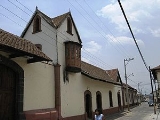
Ayapango
Encyclopedia
Ayapango is a small town and municipality
located in the southeast portion of the State of Mexico, southeast of Mexico City
. Despite the fact that this municipality is distinctly rural, it falls within the Mexico City Metropolitan Area
. The town is known for its "French style" (Spanish
afrancesado) houses built early in the last century which have names which reflect something of their characteristics. The name Ayapango is derived from "eyapanco" which roughly translates to "place where three irrigation ditches meet." This town has been designated as a "Pueblo con Encanto" (Town with Charm) by the government of the State of Mexico.
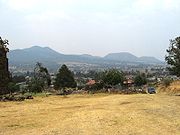 The Chichimeca
The Chichimeca
s and Teotenancas came into the Valley of Chalco, including what is now Ayapango, in the 12th and 13th centuries. They settled and eventually formed alliances with tribes that were already here. These alliances eventually coalesced into the kingdom of Itztlacozauhcan Amecamecan under a lord named Atonaltzin.
The earliest recorded data concerning Ayapango itself goes back to 1430. It relates to a noble from here by the name of Aquiauhtzin Cuauhquiyahuacatzintli, who authored a song called "The Female Enemy" and made himself famous by singing it at the palace of Axayacatl
in Tenochtitlan, the capital of the Aztecs. Axayacatl was so impressed with the song, he adopted Aquiauhtzin as his own son and gave him inheritance rights.
Sometime after this, records indicate that because of four-year drought, many here sold themselves to the Aztecs as slaves in order to survive. In 1479, winds caused crop damage and earthquakes caused a large number of homes to collapse and a number of landslides in the surrounding mountains.
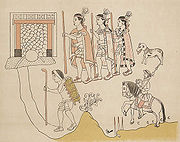 When Tenochtitlan fell to the Spanish in 1521
When Tenochtitlan fell to the Spanish in 1521
, Ayapango was under the Aztec jurisdiction of Tenango (del Aire)
. After the Conquest, the territory was reorganized so that Ayapango fell under the jurisdiction of Amecameca
, which was part of the Chalco region. Ecclesiastically, it was under the Franciscan jurisdiction of Tlalmanalco
. Ayapango was evangelized under the direction of Friar Martin de Valencia.
In 1563, the town of Ayapango was begun to be built. By 1673, what is now the municipality of Ayapango was a small collection of communities, with most of the land owned by a few wealthy landholders such as the widow of Lorenzo de San Pedro and Nicolás de Galicia, who was the chief of the town of Ayapango. Historically, the economy of Ayapango has been based on the cultivation of corn and wheat, selling the harvests in Mexico City, either by land or via what was Lake Chalco. These trips were hazardous as robbers were a serious problem. Generally, natives were not permitted to carry weapons but in the mid 18th century, Manuel de Santiago, head of the town of Ayapango, managed to get such permission for this purpose.
Up through most of the 19th century, life continued here much as it did all through the colonial period, mostly subsistence farming. The Mexican War of Independence
had no effect on life here. Ayapango gained municipality status in 1868. Originally, the municipality was larger, but in 1875, Ayapango lost the towns ot Zentlalpan and Santa Isabel Chalma to Amecameca. At the end of the 19th century, the state government considered disbanding the municipality and merging the entire territory to Amecameca because Ayapango's economic situation was precarious, making it difficult to maintain its own government.
While Ayapango mostly stayed out of the Mexican Revolution
, peasant sympathies for the rebels were strong due to poor treatment of farm workers by hacienda
owners. While the Diaz
government tried to recruit here for the federal army, most managed to avoid service. After the Revolution, two of the main haciendas, Retana and De Bautista were expropriated and converted into five ejido
s, Ayapango, San Bartolomé Mihuacán, San Martín Pahuacán, San Cristóbal Poxtla and Tlamapa.
Ayapango's official named changed to Ayapango de Gabriel Ramos Millan in 1950. This was in honor of Ramos Millan, who was born here and who created the National Commission of Corn, working to introduce new seeds and farming techniques during the first half of the century. Ramos Millan died in a plane crash on Pico del Fraile, an elevation next to Popocatépetl
and practically in front of his hometown.
In the last half of the 20th century, life began to change here. Because of the building of new roads and rehabilitation of existing ones, interaction with the outside world has greatly increased. Secondary and preparatory schools have been built, eliminating the need to travel outside the municipality for this education. However, life still remains difficult here, with many going to other towns or countries in order to find work.
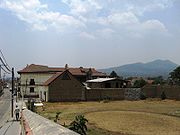 The town has a population of only 3,072. The town's most distinctive feature are the older houses that conserve a kind of a "French" style as much for their form as for the materials they are construction with. The walls are thick adobe and their roofs have two peaks covered with flat clay tile shingles. In this attic space grain is kept. Many of these homes also have large patios. Another notable fact is that these older houses have names. This comes from a pre-Hispanic custom of naming a building based on its characteristics. Many of these older homes have plaques indicating what their names are. Two of the most prominent of these homes are known as the "Casa Grande" (Big House) and the "Casa Afrancesada" (The French-style House).
The town has a population of only 3,072. The town's most distinctive feature are the older houses that conserve a kind of a "French" style as much for their form as for the materials they are construction with. The walls are thick adobe and their roofs have two peaks covered with flat clay tile shingles. In this attic space grain is kept. Many of these homes also have large patios. Another notable fact is that these older houses have names. This comes from a pre-Hispanic custom of naming a building based on its characteristics. Many of these older homes have plaques indicating what their names are. Two of the most prominent of these homes are known as the "Casa Grande" (Big House) and the "Casa Afrancesada" (The French-style House).
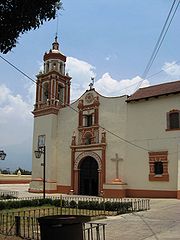 The church here, Parish of Santiago Apostol, is dedicated to Saint James. The church was part of a larger monastery complex which dates from the 16th century. Some of the remains are still visible, esp. between the church and the priest's residence, which is part of the old convent that was rebuilt. Its layout is in the form of a Latin cross. The simple façade and the tower have Baroque
The church here, Parish of Santiago Apostol, is dedicated to Saint James. The church was part of a larger monastery complex which dates from the 16th century. Some of the remains are still visible, esp. between the church and the priest's residence, which is part of the old convent that was rebuilt. Its layout is in the form of a Latin cross. The simple façade and the tower have Baroque
elements that seem to be from the transitional period from the sober and salmonic eras as the elements show aspects from both. Inside there are oil painting with images of Purgatory painted in the 18th century.
 Two kilometros south of the church is another set of Franciscan ruins called "El Calvario." This very old building was constructed on a hill of volcanic rock. The building is almost completely in ruins, in no small part due to people taking pieces of the worked stone.
Two kilometros south of the church is another set of Franciscan ruins called "El Calvario." This very old building was constructed on a hill of volcanic rock. The building is almost completely in ruins, in no small part due to people taking pieces of the worked stone.
Food here is simple, with most of the dishes keeping much of their pre-Hispanic flavor, such as mushroom soup, mixiote
, barbacoa
and mole
.
Most of municipality is grassland with a number of elevations such as Coronilla, Sacromonte, Coxtocán, Retana and Xoyacán Mountains. There are no rivers here, only a few arroyo
s that flow during the rainy season such as the Hueyatla, Tlaxcanac and Los Reyes.
As in times past, the economy is dominated by the growing of corn and wheat. Second in importance is the raising of cattle, sheep and pigs. The quality of the meat and milk is well-known and the principle industry here, the making of cheese and other dairy products is the result. Many of these are located on the farms themselves such as "El Lucero." This has attracted some tourism for its cheese and ex-haciendas such as Retana and Santa Maria, have been used a sets for Mexican movies.
In San Cristóbal Poxtla is located "El Lucero" farm, which is the principal cheese producer in the municipality. It was founded by María del Pilar García Luna, and currently run by her and her daughter, Elsa Aceves García, who permit tours of the facility. This enterprise makes a number of different types of Mexican cheese
, such as Oaxaca cheese
, which is sold in Mexico City, and the states of Puebla
, Morelos
and Guerrero
.
In contrast, the ex hacienda of Santa Cruz Tamariz is in ruins and is illegally occupied by a number of families. It is located very near the village of San Francisco Zentlalpan, which has a temple in which all of the facade, including the columns, are covered in tezontle, a blood-red porous volcanic rock.
Municipality
A municipality is essentially an urban administrative division having corporate status and usually powers of self-government. It can also be used to mean the governing body of a municipality. A municipality is a general-purpose administrative subdivision, as opposed to a special-purpose district...
located in the southeast portion of the State of Mexico, southeast of Mexico City
Mexico City
Mexico City is the Federal District , capital of Mexico and seat of the federal powers of the Mexican Union. It is a federal entity within Mexico which is not part of any one of the 31 Mexican states but belongs to the federation as a whole...
. Despite the fact that this municipality is distinctly rural, it falls within the Mexico City Metropolitan Area
Greater Mexico City
Greater Mexico City refers to the conurbation around Mexico City, officially called Mexico City Metropolitan Area , constituted by the Federal District—itself composed of 16 boroughs—and 41 adjacent municipalities of the states of Mexico and Hidalgo...
. The town is known for its "French style" (Spanish
Spanish language
Spanish , also known as Castilian , is a Romance language in the Ibero-Romance group that evolved from several languages and dialects in central-northern Iberia around the 9th century and gradually spread with the expansion of the Kingdom of Castile into central and southern Iberia during the...
afrancesado) houses built early in the last century which have names which reflect something of their characteristics. The name Ayapango is derived from "eyapanco" which roughly translates to "place where three irrigation ditches meet." This town has been designated as a "Pueblo con Encanto" (Town with Charm) by the government of the State of Mexico.
History of the town and municipality

Chichimeca
Chichimeca was the name that the Nahua peoples of Mexico generically applied to a wide range of semi-nomadic peoples who inhabited the north of modern-day Mexico and southwestern United States, and carried the same sense as the European term "barbarian"...
s and Teotenancas came into the Valley of Chalco, including what is now Ayapango, in the 12th and 13th centuries. They settled and eventually formed alliances with tribes that were already here. These alliances eventually coalesced into the kingdom of Itztlacozauhcan Amecamecan under a lord named Atonaltzin.
The earliest recorded data concerning Ayapango itself goes back to 1430. It relates to a noble from here by the name of Aquiauhtzin Cuauhquiyahuacatzintli, who authored a song called "The Female Enemy" and made himself famous by singing it at the palace of Axayacatl
Axayacatl
Axayacatl was the sixth Aztec Emperor, a ruler of the Postclassic Mesoamerican Aztec Empire and city of Tenochtitlan, who reigned from 1469 to 1481.He is chiefly remembered for subjugating Tlatelolco, Tenochtitlan's sister city, in 1473....
in Tenochtitlan, the capital of the Aztecs. Axayacatl was so impressed with the song, he adopted Aquiauhtzin as his own son and gave him inheritance rights.
Sometime after this, records indicate that because of four-year drought, many here sold themselves to the Aztecs as slaves in order to survive. In 1479, winds caused crop damage and earthquakes caused a large number of homes to collapse and a number of landslides in the surrounding mountains.

Spanish conquest of Mexico
The Spanish conquest of the Aztec Empire was one of the most important campaigns in the Spanish colonization of the Americas. The invasion began in February 1519 and was acclaimed victorious on August 13, 1521, by a coalition army of Spanish conquistadors and Tlaxcalan warriors led by Hernán Cortés...
, Ayapango was under the Aztec jurisdiction of Tenango (del Aire)
Tenango del Aire
Tenango del Aire is a town and municipality located in the southeast portion of the State of Mexico and is about 42 km southeast of Mexico City. The municipality is bordered by Temamatla, Tlalmanalco, Juchitepec, and Ayapango, Despite the fact that this municipality is distinctly rural, it...
. After the Conquest, the territory was reorganized so that Ayapango fell under the jurisdiction of Amecameca
Amecameca
Amecameca is a town and municipality located in the eastern panhandle of Mexico State between Mexico City and the Iztaccíhuatl and Popocatépetl volcanos of the Sierra Nevada mountain range. It is located on federal highway 115 which leads to Cuautla, which is called the Volcano Route...
, which was part of the Chalco region. Ecclesiastically, it was under the Franciscan jurisdiction of Tlalmanalco
Tlalmanalco
Tlalmanalco is a town and municipality located in the far south-eastern part of the State of Mexico. The name is from the Nahuatl language, meaning “flat area.” The municipality’s seal shows flat land, with a pyramid on it, representing its pre-Hispanic history, surrounded by small mountains, which...
. Ayapango was evangelized under the direction of Friar Martin de Valencia.
In 1563, the town of Ayapango was begun to be built. By 1673, what is now the municipality of Ayapango was a small collection of communities, with most of the land owned by a few wealthy landholders such as the widow of Lorenzo de San Pedro and Nicolás de Galicia, who was the chief of the town of Ayapango. Historically, the economy of Ayapango has been based on the cultivation of corn and wheat, selling the harvests in Mexico City, either by land or via what was Lake Chalco. These trips were hazardous as robbers were a serious problem. Generally, natives were not permitted to carry weapons but in the mid 18th century, Manuel de Santiago, head of the town of Ayapango, managed to get such permission for this purpose.
Up through most of the 19th century, life continued here much as it did all through the colonial period, mostly subsistence farming. The Mexican War of Independence
Mexican War of Independence
The Mexican War of Independence was an armed conflict between the people of Mexico and the Spanish colonial authorities which started on 16 September 1810. The movement, which became known as the Mexican War of Independence, was led by Mexican-born Spaniards, Mestizos and Amerindians who sought...
had no effect on life here. Ayapango gained municipality status in 1868. Originally, the municipality was larger, but in 1875, Ayapango lost the towns ot Zentlalpan and Santa Isabel Chalma to Amecameca. At the end of the 19th century, the state government considered disbanding the municipality and merging the entire territory to Amecameca because Ayapango's economic situation was precarious, making it difficult to maintain its own government.
While Ayapango mostly stayed out of the Mexican Revolution
Mexican Revolution
The Mexican Revolution was a major armed struggle that started in 1910, with an uprising led by Francisco I. Madero against longtime autocrat Porfirio Díaz. The Revolution was characterized by several socialist, liberal, anarchist, populist, and agrarianist movements. Over time the Revolution...
, peasant sympathies for the rebels were strong due to poor treatment of farm workers by hacienda
Hacienda
Hacienda is a Spanish word for an estate. Some haciendas were plantations, mines, or even business factories. Many haciendas combined these productive activities...
owners. While the Diaz
Porfirio Díaz
José de la Cruz Porfirio Díaz Mori was a Mexican-American War volunteer and French intervention hero, an accomplished general and the President of Mexico continuously from 1876 to 1911, with the exception of a brief term in 1876 when he left Juan N...
government tried to recruit here for the federal army, most managed to avoid service. After the Revolution, two of the main haciendas, Retana and De Bautista were expropriated and converted into five ejido
Ejido
The ejido system is a process whereby the government promotes the use of communal land shared by the people of the community. This use of community land was a common practice during the time of Aztec rule in Mexico...
s, Ayapango, San Bartolomé Mihuacán, San Martín Pahuacán, San Cristóbal Poxtla and Tlamapa.
Ayapango's official named changed to Ayapango de Gabriel Ramos Millan in 1950. This was in honor of Ramos Millan, who was born here and who created the National Commission of Corn, working to introduce new seeds and farming techniques during the first half of the century. Ramos Millan died in a plane crash on Pico del Fraile, an elevation next to Popocatépetl
Popocatépetl
Popocatépetl also known as "Popochowa" by the local population is an active volcano and, at , the second highest peak in Mexico after the Pico de Orizaba...
and practically in front of his hometown.
In the last half of the 20th century, life began to change here. Because of the building of new roads and rehabilitation of existing ones, interaction with the outside world has greatly increased. Secondary and preparatory schools have been built, eliminating the need to travel outside the municipality for this education. However, life still remains difficult here, with many going to other towns or countries in order to find work.
The town


Baroque architecture
Baroque architecture is a term used to describe the building style of the Baroque era, begun in late sixteenth century Italy, that took the Roman vocabulary of Renaissance architecture and used it in a new rhetorical and theatrical fashion, often to express the triumph of the Catholic Church and...
elements that seem to be from the transitional period from the sober and salmonic eras as the elements show aspects from both. Inside there are oil painting with images of Purgatory painted in the 18th century.

Food here is simple, with most of the dishes keeping much of their pre-Hispanic flavor, such as mushroom soup, mixiote
Mixiote
A mixiote is a traditional pit-barbecued meat dish in central Mexico; especially in the Basin of Mexico. It can also be prepared in an oven. It is usually made with mutton or rabbit, but chicken is also used. The meat is cubed with the bone and seasoned with pasilla and guajillo chili peppers,...
, barbacoa
Barbacoa
Barbacoa is a form of cooking meat that originated in the Caribbean with the Taíno people, from which the term "barbecue" derives. In contemporary Mexico it generally refers to meats or a whole sheep slow-cooked over an open fire, or more traditionally, in a hole dug in the ground covered with...
and mole
Mole (sauce)
Mole is the generic name for a number of sauces used in Mexican cuisine, as well as for dishes based on these sauces...
.
The municipality
As municipal seat, the town of Ayapango is the governing authority for the following communities: Mihuacán, Pahuacán, Poxtla, San Diego Chalcatepehuacán, Tlamapa, Ex-hacienda San Andrés Teticpan (Retana), Sémolo Grande, Juvencio Avendaño Méndez, Las Casitas (Tepexpan), Rancho San José, El Arenal (Camino al Arenal), Tepexpan, Rancho San Miguel, Colonia San Diego, Rancho Dos Marías, Rancho Nuestra Señora de Fátima and Predio el Calvario. The total area of the municipality is 36.63 km2 and it has a population of 6,361.Most of municipality is grassland with a number of elevations such as Coronilla, Sacromonte, Coxtocán, Retana and Xoyacán Mountains. There are no rivers here, only a few arroyo
Arroyo (creek)
An arroyo , a Spanish word translated as brook, and also called a wash is usually a dry creek or stream bed—gulch that temporarily or seasonally fills and flows after sufficient rain. Wadi is a similar term in Africa. In Spain, a rambla has a similar meaning to arroyo.-Types and processes:Arroyos...
s that flow during the rainy season such as the Hueyatla, Tlaxcanac and Los Reyes.
As in times past, the economy is dominated by the growing of corn and wheat. Second in importance is the raising of cattle, sheep and pigs. The quality of the meat and milk is well-known and the principle industry here, the making of cheese and other dairy products is the result. Many of these are located on the farms themselves such as "El Lucero." This has attracted some tourism for its cheese and ex-haciendas such as Retana and Santa Maria, have been used a sets for Mexican movies.
In San Cristóbal Poxtla is located "El Lucero" farm, which is the principal cheese producer in the municipality. It was founded by María del Pilar García Luna, and currently run by her and her daughter, Elsa Aceves García, who permit tours of the facility. This enterprise makes a number of different types of Mexican cheese
Cheeses of Mexico
Cheeses in Mexico have a history that begins with the Spanish conquest, as dairy products were unknown in pre-Columbian Mesoamerica. The Spanish brought dairy animals such as cattle, sheep, and goats as well as cheese making techniques. Over the colonial period, cheese making was modified to suit...
, such as Oaxaca cheese
Oaxaca cheese
Queso Oaxaca is a white, semihard cheese from Mexico, similar to unaged Monterey Jack, but with a mozzarella-like string cheese texture. It is named after the state of Oaxaca in southern Mexico, where it was first made. It is available in several different shapes. It is also known as quesillo...
, which is sold in Mexico City, and the states of Puebla
Puebla
Puebla officially Estado Libre y Soberano de Puebla is one of the 31 states which, with the Federal District, comprise the 32 Federal Entities of Mexico. It is divided in 217 municipalities and its capital city is Puebla....
, Morelos
Morelos
Morelos officially Estado Libre y Soberano de Morelos is one of the 31 states which, with the Federal District, comprise the 32 Federal Entities of Mexico. It is divided in 33 municipalities and its capital city is Cuernavaca....
and Guerrero
Guerrero
Guerrero officially Estado Libre y Soberano de Guerrero is one of the 31 states which, with the Federal District, comprise the 32 Federal Entities of Mexico. It is divided in 81 municipalities and its capital city is Chilpancingo....
.
In contrast, the ex hacienda of Santa Cruz Tamariz is in ruins and is illegally occupied by a number of families. It is located very near the village of San Francisco Zentlalpan, which has a temple in which all of the facade, including the columns, are covered in tezontle, a blood-red porous volcanic rock.

